By Zach Davis
Head Football Coach
Riverside High School (WV)
Twitter: @zachdavis24
Introduction:
Read coverage is one of the base concepts of our defense because it can adapt to many different formations. It allows us to get our safeties and corners involved in the run game while adjusting the run support based on the formation. It handles every formation an offense can use while giving you max numbers against the run and being able pattern match in the secondary. We really like it versus TE runs to the field because it puts our safeties into the run fit based on the release of the TE.
Base Concept
We use a traditional 50 defense where we are rushing 5 defenders on the majority of our snaps. We have the ability to drop our Ends (OLB’s) into coverage, but it is not something we do often. We also use a variety of blitzes with our inside linebackers to attack the A, B, C and D gap.
The run fits remain the same for our Ends, ILB’s, Tackles, and Nose regardless of what coverage is called, which allows our players to play fast! Our Ends are force / BCR (boot, counter, reverse) players that will squeeze all down blocks and play the quarterback versus option. The ILB’s read the triangle (Center, Both Guards, to the near back). The Tackles are spill / dive players and the Nose plays a 2 - gap technique.
Our secondary adjusts to the different formations. They are further from the football, so they have time to process. There are three calls that can be made based on the offensive formation: Sky, Cloud and Yo – Yo.
Sky Call
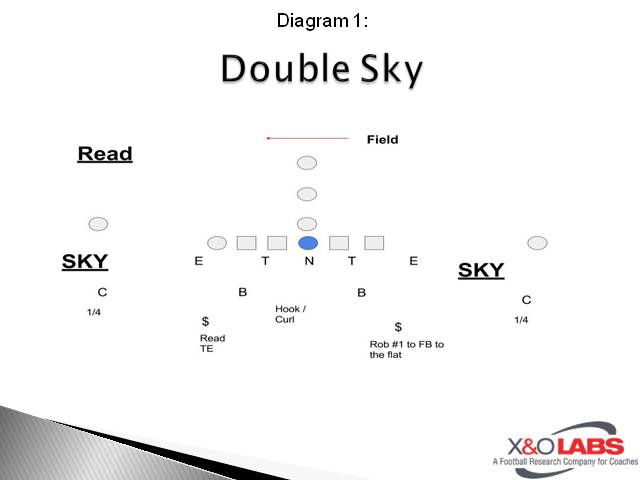
Sky is used when there is single removed receiver and a TE or Tackle. This is a version of quarters coverage where the corners have all of #1 vertical and the Safeties have #2 vertical and out. The ILB’s are hook / curl players that need to expand if a back threatens them to the flat. They will play everything from deep to short.
The safeties are looking at the EMOL for their run / pass key and the corners are pass first players that guard against play action and half back pass. This allows the safeties to be the 8th and 9th defender in the box, allowing us to get max numbers against the run. The safeties’ job is to fit off of the defenders in front of them.
As a change up, you can also call double could to this formation if you want your safeties to be able to help on the vertical by #1 or if you want your corners in a good position to play toss or jet sweep. The ILB to the TE would have to carry the TE vertical.
Cloud Call
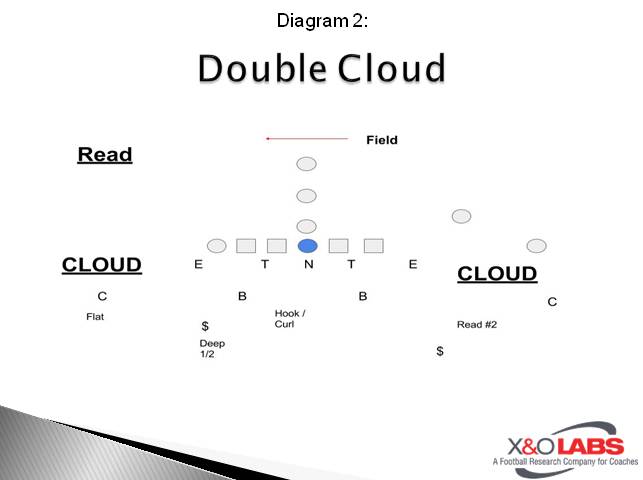
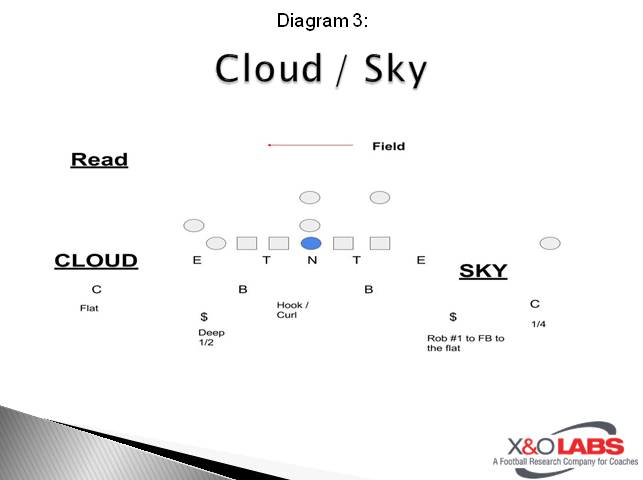
We use Cloud when there are the following situations: TE / wing, nub TE, or 2 removed receivers. This allows us to play 2 read on the #1 and #2 receiver, so we do not get picked or rubbed in the passing game.
Both the corner and the safety to the Cloud side will read the TE / wing area for their run / pass key. When then get run, both of them will fit off of the defenders in front of them.
Yo-yo Call
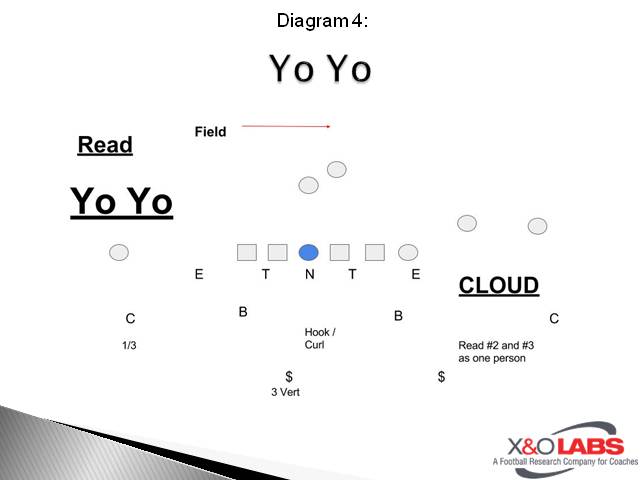
We use Yo – Yo when we get trips, so the boundary safety will poach 3 vertical and he can be an extra hat in the run game if #3 blocks. The corner to the single receiver side will play a third and the corner and safety to trips read #2 and #3 as one person. Meaning, if #2 or #3 work out, the corner will settle and the field safety will play over the top of #1.
Coaching Points:
The majority of the coaching in Read coverage comes with formation recognition. The secondary must understand when to use each of the calls (Sky, Cloud, Yo – Yo) because they are the ones that are responsible for making the coverage adjustments. They will ensure that we can get a secondary player into the run fit so we can be plus 1 in the box.
As with any defensive structure, we practice block recognition and destruction more than anything else. Your players have to be able to identify blocks and destroy blocks on defense if you want to be successful on game day. We make this scheme simple so our players can play FAST and focus on the fundamentals.
Variations:
The variations that you could see in this concept would be 10 and 20 personnel where you don’t see a TE. Read coverage is still very effective because you will get a 7-man box versus 10 personnel and an 8-max box versus 20 personnel. This coverage allows you to pattern match as well, so when a team throws the football you are in good position to match the different route concepts you will see in a game. Below are examples of how we align to 10 (Doubles and Trips) and 20 personnel.
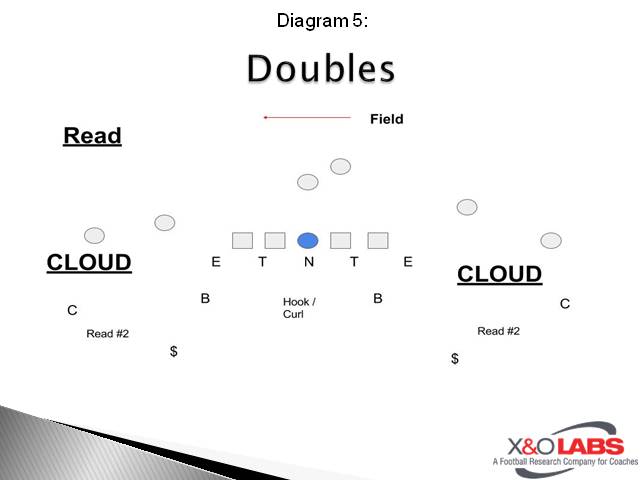
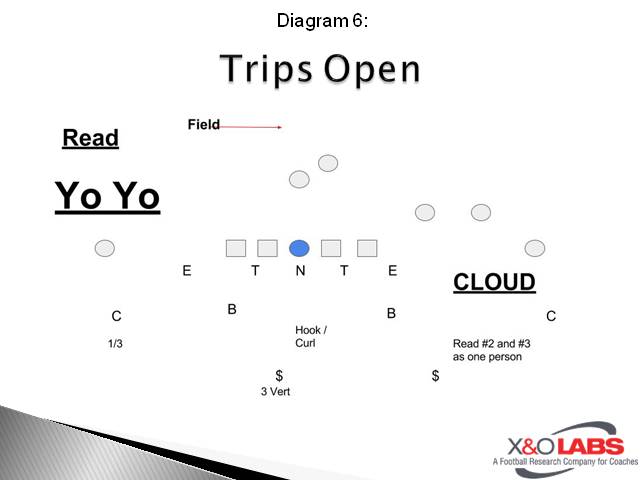
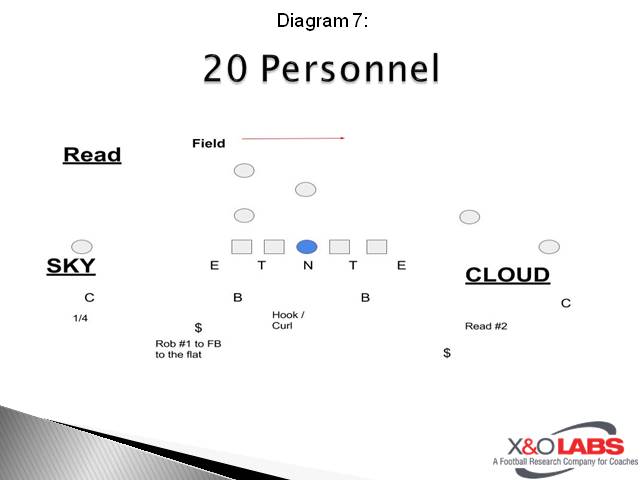
To study game film of these coverage concepts, click on the video below:
Head Football Coach
Riverside High School (WV)
Twitter: @zachdavis24
Introduction:
Read coverage is one of the base concepts of our defense because it can adapt to many different formations. It allows us to get our safeties and corners involved in the run game while adjusting the run support based on the formation. It handles every formation an offense can use while giving you max numbers against the run and being able pattern match in the secondary. We really like it versus TE runs to the field because it puts our safeties into the run fit based on the release of the TE.
Base Concept
We use a traditional 50 defense where we are rushing 5 defenders on the majority of our snaps. We have the ability to drop our Ends (OLB’s) into coverage, but it is not something we do often. We also use a variety of blitzes with our inside linebackers to attack the A, B, C and D gap.
The run fits remain the same for our Ends, ILB’s, Tackles, and Nose regardless of what coverage is called, which allows our players to play fast! Our Ends are force / BCR (boot, counter, reverse) players that will squeeze all down blocks and play the quarterback versus option. The ILB’s read the triangle (Center, Both Guards, to the near back). The Tackles are spill / dive players and the Nose plays a 2 - gap technique.
Our secondary adjusts to the different formations. They are further from the football, so they have time to process. There are three calls that can be made based on the offensive formation: Sky, Cloud and Yo – Yo.
Sky Call

Sky is used when there is single removed receiver and a TE or Tackle. This is a version of quarters coverage where the corners have all of #1 vertical and the Safeties have #2 vertical and out. The ILB’s are hook / curl players that need to expand if a back threatens them to the flat. They will play everything from deep to short.
The safeties are looking at the EMOL for their run / pass key and the corners are pass first players that guard against play action and half back pass. This allows the safeties to be the 8th and 9th defender in the box, allowing us to get max numbers against the run. The safeties’ job is to fit off of the defenders in front of them.
As a change up, you can also call double could to this formation if you want your safeties to be able to help on the vertical by #1 or if you want your corners in a good position to play toss or jet sweep. The ILB to the TE would have to carry the TE vertical.
Cloud Call


We use Cloud when there are the following situations: TE / wing, nub TE, or 2 removed receivers. This allows us to play 2 read on the #1 and #2 receiver, so we do not get picked or rubbed in the passing game.
Both the corner and the safety to the Cloud side will read the TE / wing area for their run / pass key. When then get run, both of them will fit off of the defenders in front of them.
Yo-yo Call

We use Yo – Yo when we get trips, so the boundary safety will poach 3 vertical and he can be an extra hat in the run game if #3 blocks. The corner to the single receiver side will play a third and the corner and safety to trips read #2 and #3 as one person. Meaning, if #2 or #3 work out, the corner will settle and the field safety will play over the top of #1.
Coaching Points:
The majority of the coaching in Read coverage comes with formation recognition. The secondary must understand when to use each of the calls (Sky, Cloud, Yo – Yo) because they are the ones that are responsible for making the coverage adjustments. They will ensure that we can get a secondary player into the run fit so we can be plus 1 in the box.
As with any defensive structure, we practice block recognition and destruction more than anything else. Your players have to be able to identify blocks and destroy blocks on defense if you want to be successful on game day. We make this scheme simple so our players can play FAST and focus on the fundamentals.
Variations:
The variations that you could see in this concept would be 10 and 20 personnel where you don’t see a TE. Read coverage is still very effective because you will get a 7-man box versus 10 personnel and an 8-max box versus 20 personnel. This coverage allows you to pattern match as well, so when a team throws the football you are in good position to match the different route concepts you will see in a game. Below are examples of how we align to 10 (Doubles and Trips) and 20 personnel.



To study game film of these coverage concepts, click on the video below:









